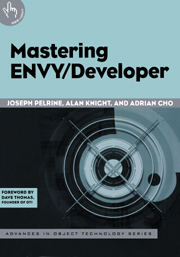Book contents
- Frontmatter
- Contents
- Foreword
- Acknowledgments
- Introduction
- Chapter 1 Getting Started
- Chapter 2 Basic Concepts
- Chapter 3 Team Development
- Chapter 4 Advanced Development
- Chapter 5 Formal Concepts
- Chapter 6 Packaging and Delivery
- Chapter 7 Extending the System
- Chapter 8 Administration
- Chapter 9 Goodies
- Chapter 10 Troubleshooting
- Appendix: A Selected Annotated API of ENVY System Classes
- Glossary
- References
- Index
Foreword
Published online by Cambridge University Press: 11 January 2010
- Frontmatter
- Contents
- Foreword
- Acknowledgments
- Introduction
- Chapter 1 Getting Started
- Chapter 2 Basic Concepts
- Chapter 3 Team Development
- Chapter 4 Advanced Development
- Chapter 5 Formal Concepts
- Chapter 6 Packaging and Delivery
- Chapter 7 Extending the System
- Chapter 8 Administration
- Chapter 9 Goodies
- Chapter 10 Troubleshooting
- Appendix: A Selected Annotated API of ENVY System Classes
- Glossary
- References
- Index
Summary
This book describes ENVY/Developer and its use by three very experienced professional software developers who have used it to build both successful products, including Top Link and VA/Java, and applications for numerous customers. Their unique user-oriented perspectives give developers and managers insight into how to use the product successfully in team development projects.
ENVY/Developer began as Orwell (OOPSLA reference), a research prototype developed in the Object Oriented Research Group, at Carleton University. It was built as part of the Actra project; a multiprocessor embedded Smalltalk, funded by the Defense Research Establishment Ottawa. Orwell addressed the problem of coordinating multiple developers working in the OO RAD environment of Smalltalk.
In designing Orwell, we sought to address the needs of our funding agency DREO, in particular Dr. Brian Barry who would later become CTO, then CEO of Object Technology International (OTI) and was interested in versioning configuration management for Smalltalk. Our goal was to meet the needs of our development team, which meant preserving the incremental nature of the Smalltalk programming environment.
What we developed at Carleton, then quickly re-implemented at OTI, was a strong specific solution for Smalltalk. Little did we know at the time how strong and specific it was to be! It was developed as an internal tool to support building embedded systems, hence the strict rules for compatibility, which were designed to reduce the downstream problems of the packaging or roaming engineer.
- Type
- Chapter
- Information
- Mastering ENVY/Developer , pp. xv - xviiiPublisher: Cambridge University PressPrint publication year: 2001

